By Heather N. Kolich, ANR Agent, UGA Extension Forsyth County, December 2021
In the dark, cold days of winter, seeing a flowering plant can raise spirits. In addition to pansies, we can enjoy several winter-blooming shrubs. As added bonuses, many are suited for shade, and some add fragrance to frosty winter air. Here are some winter bloomers suited for North Georgia.
Herbaceous winter flowering plants

Pansy and Viola – (Viola x wittrockiana, Viola tricolor)
The bright flowers of violas and pansies have made them popular winter bedding plants for hundreds of years. Forming into small 6-inch mounds, these annuals bloom throughout the winter and spring, offering a variety of colors and color combinations.
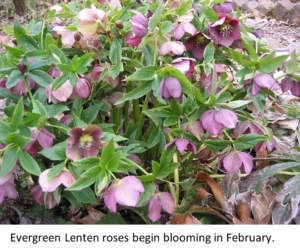
Lenten rose – (Helleborus orientalis)
Developing into clumps up to 2 feet tall and 3 feet wide, perennial, evergreen Lenten roses are ideal for naturalized woodlands. Because they spread, they’re also ideal for holding slopes with style. Bell-like white to lavender flowers appear around February and continue to bloom for several weeks. These resilient plants are easy to propagate and share. The ones at my house originated from my mom’s house, and proliferated at another house in between.
Winter flowering shrubs
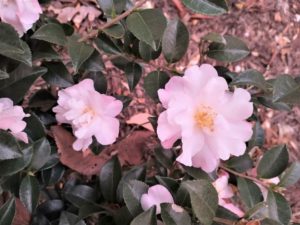
Camellia – (Camellia japonica and C. sasanqua) Earlier this fall, I planted a dwarf sasanqua camellia in a small, shady garden bed at the side of my house. Camellias are evergreen shrubs known as “the winter rose.” This little plant started putting out an abundance of pale pink flowers in mid-November, and still has more to come. Dwarf sasanquas are very slow growers, topping out at 3-5 feet tall. The plant I selected has a single stem since I plan to grow it as a tree-form. Regular camellias, both japonica and sasanqua, can reach 15 feet tall over time. Flowers range from white to pink to red, and forms include single, rose, peony, and double.
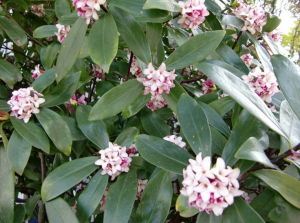
Winter daphne – (Daphne odora) Winter daphne is another slow-growing, small (3-4 feet), evergreen shrub with stunning, fragrant flowers that present in a clustered sphere in shades of white to pale pink. It can be difficult to grow, but in a protected spot with deep, well-drained, woodland soil, it can put on an irresistible winter show.
.
.
.
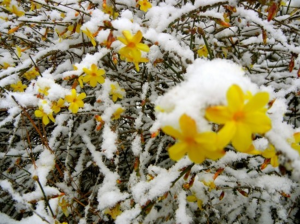
Winter Jasmine – (Jasminum nudiflorum)
A semi-deciduous shrub reaching 3-5 feet tall, winter jasmine blooms with star-like yellow flowers in nearly leafless, arching branches in late winter to early spring. It tolerates partial shade, poor soil, heavy pruning, and resists deer damage. Branches may root where they touch the soil, so it can be used as ground cover and on slopes.
.
.
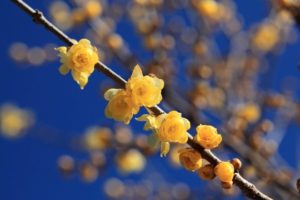
Wintersweet – (Chimonanthus praecox)
Moving up in size, wintersweet is a deciduous, 10-15 tall shrub with an open, arching form. Fragrant, delicate yellow flowers begin blooming in January. It can be planted in sun to partial shade, exhibits slow to medium growth, and tolerates severe pruning.
.
.
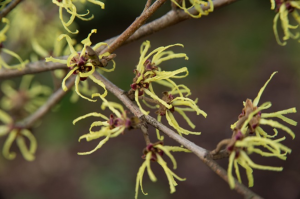
Witch hazel – (Hamamelis spp.)
Native witch hazels (H. virginiana, H. vernalis, and H. ovalis) are large shrubs reaching 10-25 feet tall at maturity. Flower buds open with tassel-like petals from October to March, depending on variety. Flower color also varies from yellow to orange to red. An interesting feature of witch hazels is that they can have flowers and fruit on branches at the same time. Witch hazels thrive in light shade to full sun.
Hopefully, as we’re out and about this winter, we’ll encounter some of these blooming winter plants and enjoy a moment of beauty – and maybe be inspired to add some winter bloomers to our own landscapes.